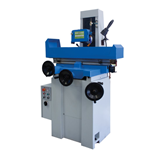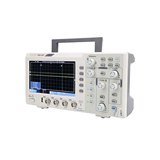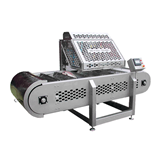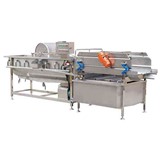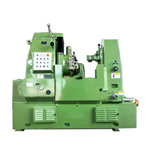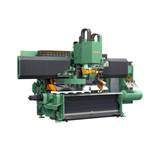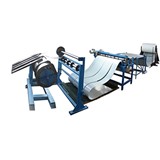Discover the best cardboard & plastic balers in Australia. Our buying guide covers prices, types, and key tips to help you make the right purchase.
Key Takeaways
- Machine Types: Vertical balers (for small-scale operations) and horizontal balers (for high-volume applications).
- Pricing: Balers range from $3,000 for smaller vertical models to $30,000+ for large horizontal balers.
- Operational Costs: Maintenance costs range from $1,000 to $3,000 annually, plus electricity and consumables.
- Financing: Equipment financing in Australia can cover up to 100% of the purchase, with terms of 1–5 years and interest rates around 5%–10%.
- Compliance: Ensure the baler meets AS/NZS 4024 safety standards before purchasing.
- Warranties: Balers typically come with 12-month warranties for parts and service, with extended options available for larger machines.
Introduction
A cardboard and plastic baler is essential for waste management and recycling businesses, compacting materials into manageable bales for easier handling and transport. Whether you're buying your first baler or upgrading, understanding the types, costs, maintenance, and certifications will help you make an informed decision. This guide covers everything you need to know about purchasing and operating a baler in Australia, from pricing to compliance and maintenance.
Types of Cardboard & Plastic Balers
1. Vertical Balers
Vertical balers are compact, easy to use, and suitable for small to medium-sized businesses. They are commonly used for low to moderate volumes of waste.
- Ideal for: Smaller operations or businesses with limited floor space.
- Capacity: Typically up to 500 kg per bale.
- Price Range: $3,000 to $8,000.
- Common Applications: Retail stores, small warehouses, or offices.
2. Horizontal Balers
Horizontal balers are larger, more powerful machines designed for high-volume waste processing. They are generally more expensive but offer greater efficiency for large-scale operations.
- Ideal for: High-volume processing and large businesses.
- Capacity: Typically up to 1,500 kg per bale or more.
- Price Range: $15,000 to $30,000 or higher.
- Common Applications: Recycling plants, large manufacturing facilities, or industrial sectors.
Pricing Overview
Initial Purchase Price
As mentioned earlier, baler prices in Australia can vary widely depending on the size and capacity of the machine. Here’s a breakdown:
- Small Vertical Balers: $3,000 – $ 8,000.
- Mid-Sized Vertical Balers: $8,000 – $ 15,000.
- Large Horizontal Balers: $15,000 – $ 30,000+.
Additional Costs
When budgeting for a baler, it’s essential to factor in ongoing costs:
- Maintenance: Annual maintenance costs range from $1,000 to $3,000 based on machine size and frequency of use.
- Electricity: Depending on the baler model, operational electricity costs can range from $500 to $1,500 per year.
- Hydraulic Fluid: Depending on usage, balers may require hydraulic fluid replacement, costing $200 to $500 annually.
How Cardboard & Plastic Balers Operate
Balers operate by using hydraulic force to compact materials into dense, uniform bales. Here's a breakdown of the typical baling process:
- Material Feeding: Waste materials like cardboard or plastic are fed into the machine via an opening.
- Compaction: Hydraulic rams compress the material into the bale chamber, where the material is compacted into dense bales.
- Binding: After the material is compacted, the machine uses wire or string to bind the bale securely.
- Ejection: The finished bales are ejected from the baler, ready for transport or storage.
Key Features to Look for:
- Automatic or Manual Operation: Automatic machines are more efficient but also pricier.
- Bale Size and Weight: Consider the size and weight that your facility can handle and store.
- Cycle Time: A faster cycle time means more bales per hour, which can be crucial for large operations.
Maximising Efficiency and Space Utilisation
Choosing the right baler is only half the battle. To get the most out of your investment, you need to optimise its efficiency and space utilisation. Here are a few key considerations:
Bale Size and Density
The larger and denser the bale, the more space you save, and the more cost-effective the transport becomes.
- Vertical Balers: Produce smaller bales, typically around 500 kg. While these may be easier to handle manually, they take up more space in the storage area.
- Horizontal Balers: Produce larger bales, which can help maximise space. These are ideal for businesses with ample storage space and higher volumes of waste.
Optimising Throughput
- Automatic vs. Manual Operation: Automatic balers tend to be more efficient, allowing for continuous operation with minimal downtime. While they are more expensive, they may be more cost-effective for larger businesses.
- Speed: High-throughput balers can bale up to 40 bales per hour for horizontal models and 15-20 bales per hour for vertical ones.
Maintenance Considerations
Regular maintenance is essential for the longevity and smooth operation of your baler. Here are key aspects to consider:
- Hydraulic System: Check hydraulic fluid levels regularly to ensure efficient operation.
- Electrical Components: Ensure the electrical system is functioning properly to avoid downtime.
- Wearing Parts: Belts, seals, and wire cutters may need replacing over time, especially in high-volume applications.
- Bale Ejector: The bale ejector needs to be cleaned and lubricated periodically to prevent jamming.
Financing and Warranties: Key Considerations for Australian Buyers
Purchasing a baler is a significant investment, and most businesses will require financing to cover the costs. Here are some options and things to consider when financing your purchase:
Financing Options
- Equipment Leasing: Leasing is a great option for businesses that need the equipment but may not have the capital to purchase outright. With lease terms ranging from 1 to 5 years, you can conserve your cash flow while still benefiting from the baler’s productivity.
- Hire Purchase: This option allows you to purchase the baler over time, with ownership transferred at the end of the agreement. Hire purchase is ideal for businesses that want to own the equipment outright once it’s paid off.
- Business Loans: If you have a strong credit rating, a traditional business loan may be the best option. Interest rates in Australia typically range from 5% to 10% per annum.
Warranty Terms
Baler warranties typically last for 12 months, covering parts and service. Extended warranties may be available, especially for larger or more expensive models. Make sure to understand what’s covered and whether the warranty includes:
- Parts replacement
- Labour costs
- Regular maintenance
Understanding Compliance and Safety Standards in Australia
Compliance with Australian safety standards is crucial to avoid costly fines and ensure a safe working environment. Here are the key regulations and certifications you should be aware of:
AS/NZS 4024 Safety Standards
This is the Australian/New Zealand standard for machinery safety. Ensure that any baler you purchase complies with these standards to guarantee that it meets the necessary safety requirements.
Workplace Health and Safety (WHS) Compliance
Baling machines can be dangerous if not operated properly. Ensure that your staff receives proper training and that your baler complies with WHS guidelines. It’s important that your baler includes safety features such as:
- Emergency stop buttons
- Automatic shutdowns in case of a fault
- Protective barriers to prevent workers from coming into contact with moving parts
Common Questions from Cardboard & Plastic Baler Buyers
1. What is the best baler for a small business?
For small businesses, a vertical baler is typically the best option. These are more affordable, compact, and ideal for lower-volume waste processing. They can handle up to 500 kg per bale, making them ideal for smaller spaces and operations.
2. How long do balers typically last?
With proper maintenance, most balers can last between 10 to 15 years. Regular service and timely replacement of key parts can extend the machine’s lifespan significantly.
3. What are the maintenance costs for a baler?
Maintenance costs can vary depending on the size of the machine and frequency of use. Small vertical balers typically incur lower costs (around $1,000 per year), while larger horizontal balers may require more extensive service and cost up to $3,000 annually.
4. Can I finance the purchase of a baler?
Yes, many suppliers and lenders offer financing options, including leasing and hire purchase, to help businesses spread the cost of purchasing a baler.
Conclusion
Purchasing a cardboard and plastic baler is a significant investment for businesses in the recycling and waste management sector. By understanding the different types of balers, their prices, and operational costs, you can make a well-informed decision. Don’t forget to factor in maintenance, financing, and compliance to ensure your purchase meets both your operational needs and legal requirements.
With the right baler, you’ll increase efficiency, reduce waste handling costs, and contribute positively to your environmental impact.



-160x160-state_article-rel-cat.png)
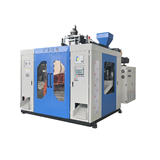
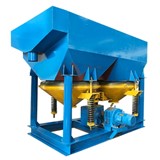

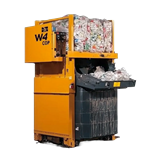
-160x160-state_article-rel-cat.png)
